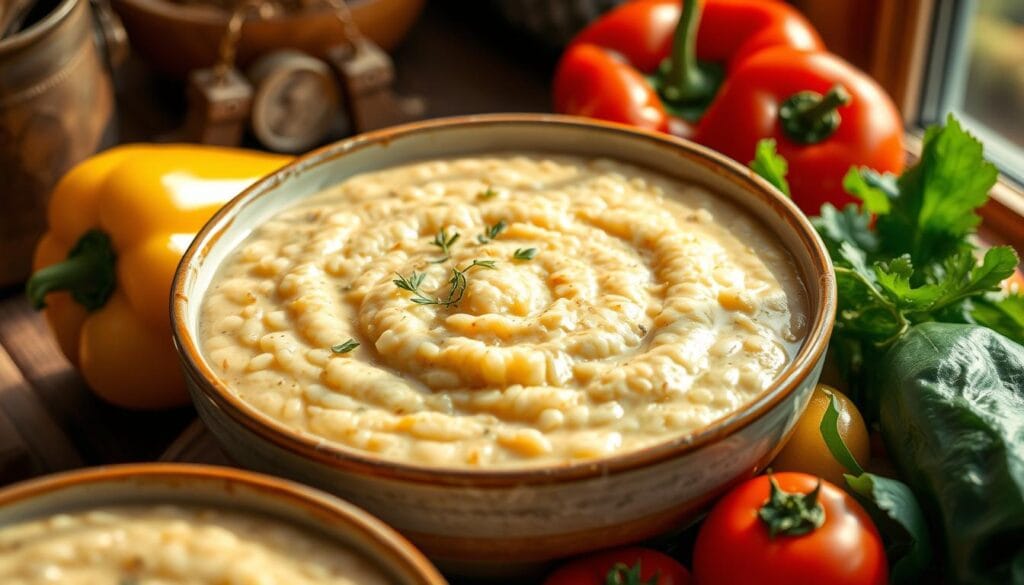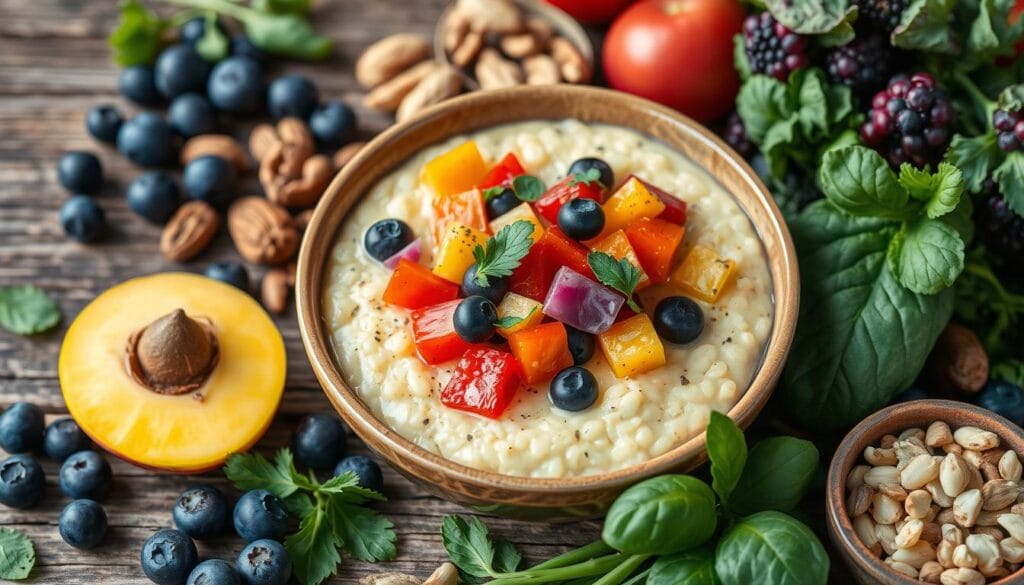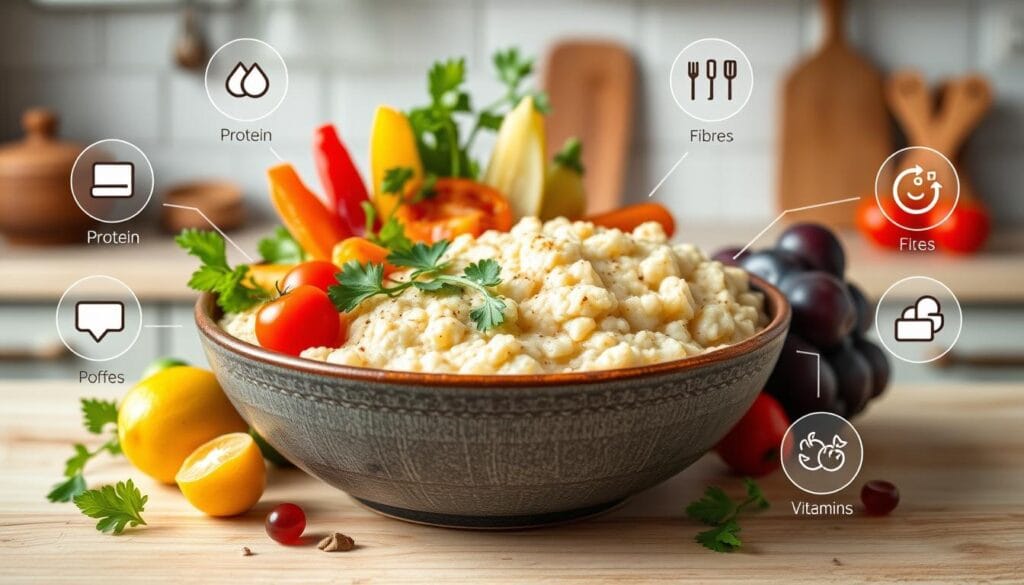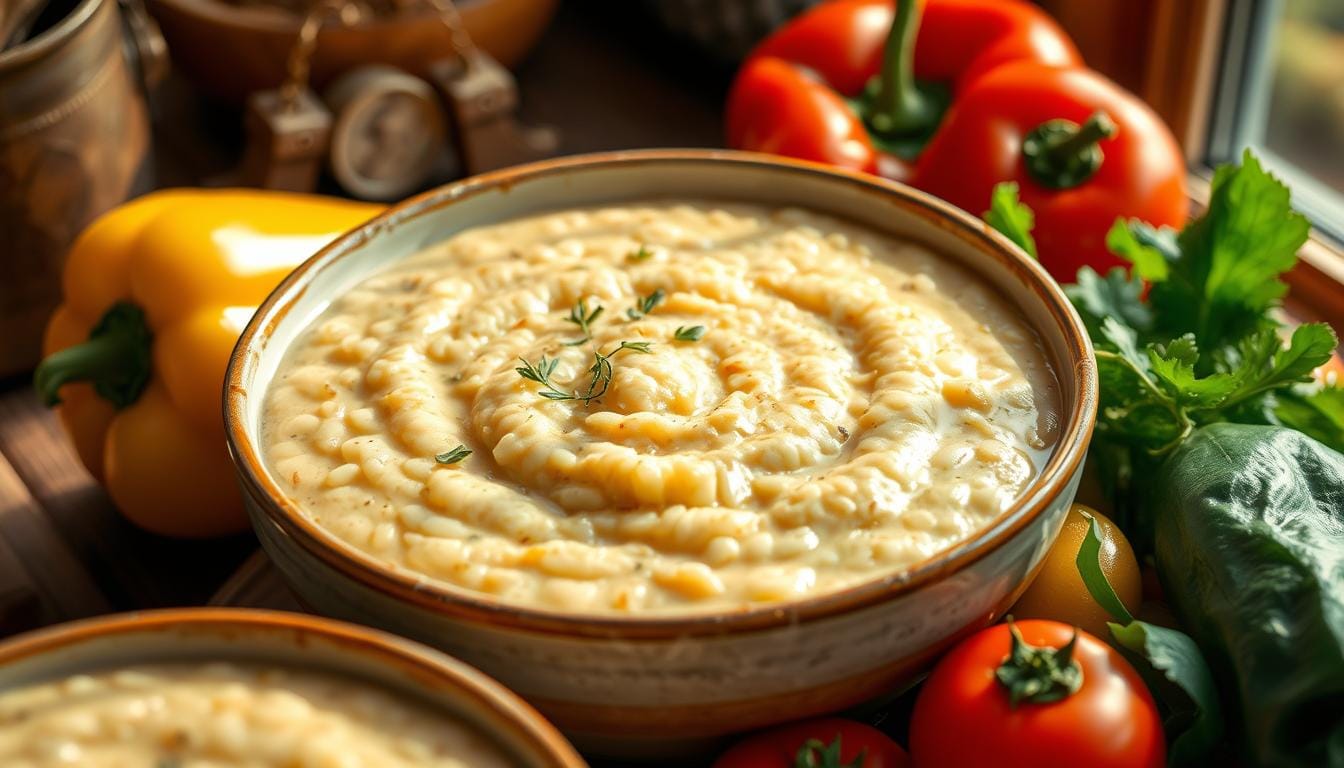Hominy Grits Nutritional Value: A Comprehensive Guide to Health Benefits
Hominy grits are a key part of Southern cuisine, made from ground corn. They come in various forms like stone-ground, hominy, regular, and instant. These grits are packed with nutrients like iron, B vitamins, and fiber.
They are also gluten-free, making them a great choice for a balanced diet. When prepared with care, they can be a healthy addition to your meals.

Table of Contents
Understanding Hominy Grits Nutritional : Origins and Processing Methods
Hominy grits are a favorite in the Southern United States. They come from Native American cuisine. These dried corn kernels, or “dent corn,” have been around for centuries.
Traditional Stone-Ground Processing
The old way to make stone-ground grits is by milling corn between stones. This keeps more of the corn’s nutrients. It also gives a unique taste and texture. Stone-ground grits are loved for their natural goodness and real flavor.
Modern Commercial Processing
Now, we have quick-cooking and instant grits thanks to new methods. These are convenient but might lose some nutrients. Still, they cook fast, which is great for people who are always on the go.
Nixtamalization Process
The nixtamalization process is key in making hominy grits. It soaks and cooks the corn in a special solution. This makes the grits taste better, smell nicer, and be more nutritious. It also makes niacin easier to get.
Whether you like the rich taste of stone-ground grits or the ease of quick-cooking ones, hominy grits are versatile. They’re good in many dishes, like stews and breakfast bowls.
Essential Nutritional Components of Grits
Grits are a key food in the American South, full of important nutrients. They have carbs, fiber, protein, and vitamins. Knowing what’s in grits helps you choose better for your diet.
Carbohydrates and Fiber
Grits give you energy thanks to carbs. The fiber in them depends on how they’re made. Stone-ground grits keep more fiber, keeping nutrients whole. Instant grits have less fiber, about 2 grams per cup, because they’re processed more.
Protein and Vitamins
Enriched instant grits have 3 grams of protein and lots of iron. They also have B vitamins like thiamin and folate. These vitamins help your body work right. Plus, grits have antioxidants good for your eyes.
| Nutrient | Stone-Ground Grits | Instant Grits | Enriched Instant Grits |
|---|---|---|---|
| Calories | – | 156 kcal | 156 kcal |
| Carbohydrates | – | 36g | 36g |
| Fiber | Highest | 2g | 2g |
| Protein | – | 3g | 3g |
| Added Sugar | – | 0g | 0g |
| Iron | – | 100% DV | 100% DV |
Eating grits can be good for you, especially with healthy foods. Knowing about grits nutrition facts and nutrients in hominy grits helps you eat better.
Macronutrient Profile and Caloric Content
A one-cup serving of cooked hominy grits has about 182 calories. It has 38 grams of carbohydrates, 4.4 grams of protein, and 1.18 grams of fat. Grits are mostly carbs, with some protein and very little fat.
Protein Content and Quality
The protein in hominy grits is not complete. It lacks some amino acids. So, while grits have protein, it’s not as good as animal or some plant proteins.
Carbohydrate Structure
The carbohydrates in hominy grits are complex. They give energy slowly, not quickly. This makes grits good for keeping blood sugar steady and energy levels even.
Fat Content Analysis
Hominy grits have very little fat, just 1.18 grams per cup. Most of this fat is unsaturated, which is good for the heart when eaten right.
| Nutrient | Hominy Grits (1 cup, cooked) | Rice (1 cup, cooked) |
|---|---|---|
| Calories | 182 | 206 |
| Carbohydrates | 38g | 45g |
| Protein | 4.4g | 4.3g |
| Fat | 1.18g | 0.4g |
| Fiber | 4g | 0.6g |
Vitamins and Minerals in Hominy Grits
Hominy grits are more than just a tasty breakfast. They are packed with nutrients that boost your health. These grains are rich in vitamins and minerals that are good for you.
Iron is a key nutrient in hominy grits. A 100-gram serving has 4.42 milligrams of iron. This is 8% of what you need daily. Iron helps prevent anemia, especially for those at risk.
Hominy grits are also a good source of folate. They give you 24% of your daily folate needs in 100 grams. Folate is important for cell growth and is key during pregnancy. Grits also have 18% of thiamin (vitamin B1) and 13% of niacin (vitamin B3) in a serving.
Other important nutrients in grits include zinc, selenium, and vitamin B6. These help your immune system, protect against damage, and help your body use energy. Adding grits to your diet can improve your health.
The nutrients in grits can change based on how they’re made. Stone-ground grits keep more of their natural fiber and nutrients. Enriched grits may have extra vitamins and minerals added to make them healthier.
Hominy grits are great for breakfast, as a side, or in recipes. They add value to a healthy diet. Knowing what nutrients they have helps you make better choices for your health.
Fiber Content and Digestive Health Benefits
Hominy grits, especially the stone-ground kind, are packed with fiber. A 100-gram serving has about 4.8 grams of fiber. This meets 17% of what we need daily. This fiber is key for a healthy digestive system.
Soluble vs Insoluble Fiber in Hominy Grits
Hominy grits have both soluble and insoluble fiber. Soluble fiber helps control cholesterol and blood sugar. Insoluble fiber keeps bowel movements regular and the gut healthy. These fibers work together to improve digestion.
Impact on Gut Health
The fiber in hominy grits feeds the good bacteria in our gut. This supports the growth of beneficial microbes. They are vital for our immune system, nutrient absorption, and digestive health. Adding hominy grits to your meals can boost your gut health.
| Nutrient | Amount per 100g | % Daily Value |
|---|---|---|
| Fiber | 4.8g | 17% |
| Soluble Fiber | 1.3g | N/A |
| Insoluble Fiber | 3.5g | N/A |
The fiber in hominy grits is great for a healthy diet. It boosts digestive health and overall well-being.
Antioxidant Properties and Disease Prevention
Grits are a favorite in Southern cuisine, loved for their taste and health benefits. They have antioxidants like lutein and zeaxanthin, which are good for your eyes. These can help prevent age-related macular degeneration.
Grits are more than just a tasty breakfast. They also have carotenoids and polyphenols. These help your immune system and fight cell damage from free radicals. They might lower the risk of heart disease, type 2 diabetes, and some cancers.
Quercetin in corn, found in grits, could help with prostatitis. It might also protect against Alzheimer’s and dementia. Plus, grits’ fiber helps control blood sugar and supports digestion, boosting overall health.
Choose darker grits for more antioxidants. They have more beneficial compounds than lighter ones. Adding grits to your diet can bring both great taste and health benefits.
“Grits are not just a delicious breakfast – they’re a powerhouse of antioxidants that can help protect your health in numerous ways.”

Blood Sugar Management and Glycemic Index
Grits can affect blood sugar levels. They are high in carbs and their glycemic index changes based on how they’re made. Cooked grits usually have a glycemic index between 40 and 69, which is moderate.
Insulin Response
The carbs in grits can cause an insulin response. This can impact blood sugar levels. A 100g serving of cooked grits has about 15g of carbs and a glycemic load of 8.25.
This means grits can slightly raise blood sugar. They are okay for people with diabetes if eaten in small amounts and with other healthy foods.
Diabetic Considerations
People with diabetes should watch their grits intake. Stone-ground grits are better than instant grits because they have a lower glycemic index. Adding protein and fiber can also help control blood sugar.
Those with corn allergies should be careful with grits. They are made from ground corn and can cause allergic reactions.
| Nutrient | Amount per 100g of Cooked Grits |
|---|---|
| Calories | 71 kcal |
| Carbohydrates | 15 g |
| Protein | 1.5 g |
| Fiber | 0.6 g |
Knowing about grits and blood sugar can help people with diabetes make better food choices. They can add grits to a healthy diet in a balanced way.
Weight Management and Satiety Effects
Grits can help with weight management. They have fiber that makes you feel full. This can help you lose weight.
But, adding butter and cheese can add a lot of calories. To get the most benefits, make your grits with healthy ingredients. Eat them in moderation as part of a balanced diet.
Research shows that grits’ resistant starch helps with weight management. It supports healthy gut bacteria and reduces insulin resistance. It also makes you feel full. Plus, its moderate glycemic index helps control blood sugar levels.
| Nutrient | Amount per 100g of Cooked Grits |
|---|---|
| Calories | 71 kcal |
| Total Carbohydrates | 15g |
| Fiber | 0.6g |
| Protein | 1.5g |
| Total Fat | 1.84g |
Grits can be a nutritious choice for weight management. They are satisfying when part of a balanced diet. Focus on nutrient-rich preparations and portion control for grits for weight loss and grits satiety.

Healthy Preparation Methods and Serving Suggestions
To get the most out of healthy grits recipes, focus on cooking methods that add nutrients. Pairing grits with other healthy foods makes for balanced meals with grits. This way, you feed your body well and enjoy great taste.
Nutrient-Rich Cooking Techniques
Choose water, low-fat milk, or broth when cooking grits. Avoid heavy creams and high-fat dairy. This keeps the grits’ nutrients and cuts down on calories and fat. Add fresh veggies like mushrooms, spinach, or bell peppers to your grits. They bring more vitamins, minerals, and fiber.
Balanced Meal Combinations
- Pair grits with lean proteins like grilled shrimp, baked chicken, or poached eggs for a balanced meal.
- Top your grits with fresh fruits like berries or sliced peaches for natural sweetness and antioxidants.
- Sprinkle chopped nuts or seeds, like almonds or pumpkin seeds, over your grits for healthy fats and crunch.
- Add leafy greens like kale or spinach to boost the fiber and nutrient content of your balanced meals with grits.
By using these healthy cooking and serving tips, you can make the most of grits. Enjoy them as a key part of a nutritious diet.
Conclusion
Hominy grits can be a great addition to a healthy diet if made right. They are packed with B vitamins, iron, and fiber. Even though they have a lot of carbs, you can still make them part of a healthy meal.
Choosing whole grain grits and controlling your portions is key. Adding nutritious toppings can make your grits even better. This way, you can enjoy the comfort of grits while staying healthy.
The nutritional value of hominy grits makes them a great part of a balanced diet. They’re perfect for breakfast, as a side, or in your favorite recipes. By knowing how to prepare them, you can make the most of this Southern classic.
Enjoying grits is all about finding the right mix of taste, nutrition, and portion size. With a bit of creativity and care, you can enjoy the comforting taste of grits while keeping your health in mind.
FAQ
What are the health benefits of hominy grits?
Hominy grits are a nutritious grain. They are rich in vitamins and minerals like iron, B vitamins, and fiber. They also have antioxidants that may lower disease risk.
How do the different processing methods affect the nutritional value of grits?
The way grits are processed can change their nutritional value. Stone-ground grits keep more nutrients than instant grits. The nixtamalization process in hominy grits boosts their flavor and nutrients.
What are the key nutrients found in hominy grits?
Hominy grits are packed with complex carbs, protein, and vitamins and minerals. They are rich in iron, folate, thiamin, and niacin. They also have zinc, selenium, and vitamin B6.
How do the macronutrients in grits compare to other grains?
Grits are mostly carbs, with some protein and little fat. Their carbs are complex, giving long-lasting energy. But, they lack some amino acids, making their protein incomplete.
What are the fiber and antioxidant benefits of hominy grits?
Hominy grits have both soluble and insoluble fiber. This supports digestion and weight management. They also have antioxidants like lutein and zeaxanthin, which protect the eyes and may lower chronic disease risk.
How do grits affect blood sugar levels?
Grits are high in carbs and can raise blood sugar. Their glycemic index depends on processing and preparation. People with diabetes should watch portion sizes and pair grits with protein and fiber to control blood sugar.
Can grits be part of a weight management plan?
Yes, grits can fit into a weight management plan if eaten in moderation. Their fiber helps you feel full, aiding in weight loss. But, avoid high-calorie toppings like butter and cheese.
How can I incorporate grits into a healthy, balanced diet?
Cook grits in water, low-fat milk, or broth for better nutrition. Add veggies, lean proteins, and healthy fats for balanced meals. Choose toppings like fruits, nuts, or avocado instead of fatty ones. Pair grits with eggs, shrimp, or chicken for protein, and add leafy greens or veggies for more nutrients and fiber.
DID OUR INFORMATION HELP YOU ?
There are no reviews yet. Be the first one to write one.

